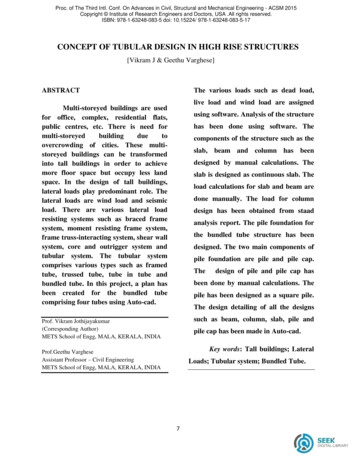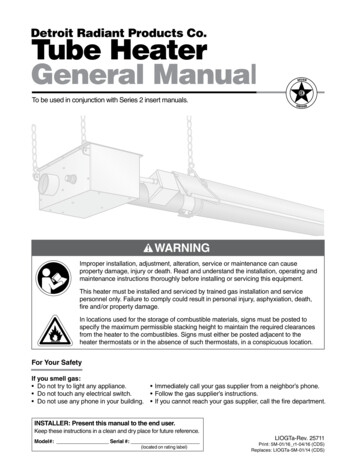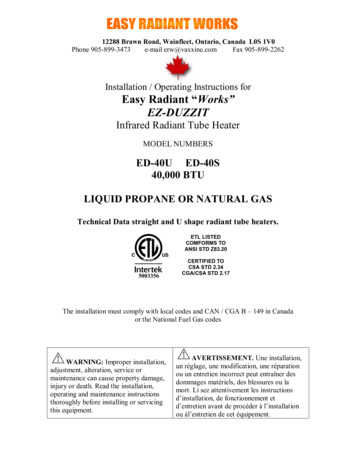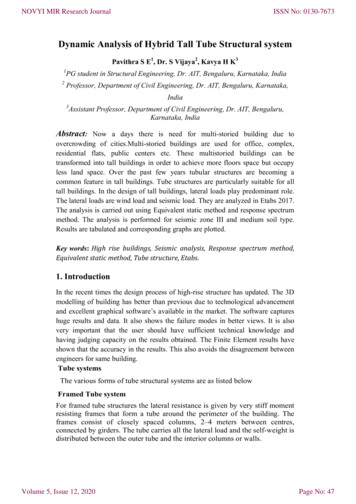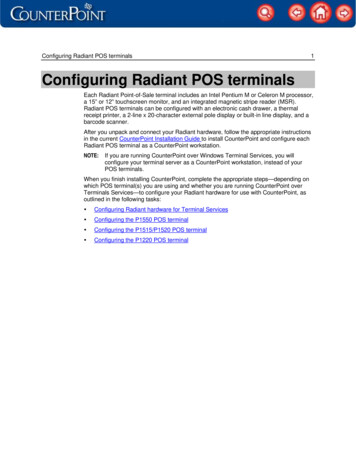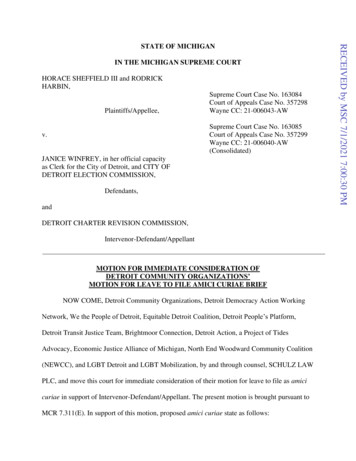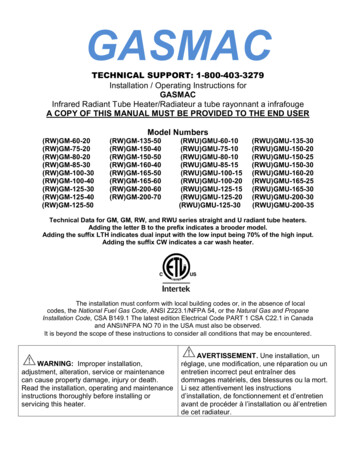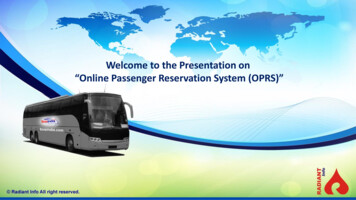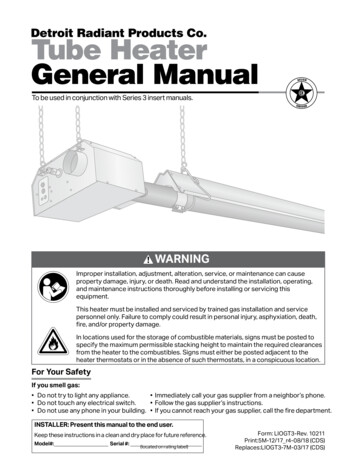
Transcription
Detroit Radiant Products Co.Tube HeaterGeneral ManualTo be used in conjunction with Series 3 insert manuals.!WARNINGImproper installation, adjustment, alteration, service, or maintenance can causeproperty damage, injury, or death. Read and understand the installation, operating,and maintenance instructions thoroughly before installing or servicing thisequipment.This heater must be installed and serviced by trained gas installation and servicepersonnel only. Failure to comply could result in personal injury, asphyxiation, death,fire, and/or property damage.In locations used for the storage of combustible materials, signs must be posted tospecify the maximum permissible stacking height to maintain the required clearancesfrom the heater to the combustibles. Signs must either be posted adjacent to theheater thermostats or in the absence of such thermostats, in a conspicuous location.For Your SafetyIf you smell gas: Do not try to light any appliance. Immediately call your gas supplier from a neighbor’s phone. Do not touch any electrical switch. Follow the gas supplier’s instructions. Do not use any phone in your building. If you cannot reach your gas supplier, call the fire department.INSTALLER: Present this manual to the end user.Keep these instructions in a clean and dry place for future reference.Model#: Serial #:(located on rating label)Form: LIOGT3-Rev. 10211Print:5M-12/17 r4-08/18 (CDS)Replaces:LIOGT3-7M-03/17 (CDS)
Contents1.0 Introduction . . . . . . . . . . . . . . . . . . . . . . . . . . . . . . . . . . . . . . . . . . . . . . . . . . . . . . . . . . . . . . . . . . . . . . . . . . . . . .3Overview . . . . . . . . . . . . . . . . . . . . . . . . . . . . . . . . . . . . . . . . . . . . . . . . . . . . . . . . . . . . . . . . . . . . . . . . . . . 3Heater Components . . . . . . . . . . . . . . . . . . . . . . . . . . . . . . . . . . . . . . . . . . . . . . . . . . . . . . . . . . . . . . . . 32.0 Safety . . . . . . . . . . . . . . . . . . . . . . . . . . . . . . . . . . . . . . . . . . . . . . . . . . . . . . . . . . . . . . . . . . . . . . . . . . . . . . . . . . . . 4Warning Symbols . . . . . . . . . . . . . . . . . . . . . . . . . . . . . . . . . . . . . . . . . . . . . . . . . . . . . . . . . . . . . . . . . . .4Applications . . . . . . . . . . . . . . . . . . . . . . . . . . . . . . . . . . . . . . . . . . . . . . . . . . . . . . . . . . . . . . . . . . . . . . . . 4Clearances to Combustibles . . . . . . . . . . . . . . . . . . . . . . . . . . . . . . . . . . . . . . . . . . . . . . . . . . . . . . . 5Safety Signs and Labels . . . . . . . . . . . . . . . . . . . . . . . . . . . . . . . . . . . . . . . . . . . . . . . . . . . . . . . . . . . . 5Venting . . . . . . . . . . . . . . . . . . . . . . . . . . . . . . . . . . . . . . . . . . . . . . . . . . . . . . . . . . . . . . . . . . . . . . . . . . . . .6Gas Supply . . . . . . . . . . . . . . . . . . . . . . . . . . . . . . . . . . . . . . . . . . . . . . . . . . . . . . . . . . . . . . . . . . . . . . . . . 6Heater Expansion . . . . . . . . . . . . . . . . . . . . . . . . . . . . . . . . . . . . . . . . . . . . . . . . . . . . . . . . . . . . . . . . . . 6Standards, Certifications, and Government Regulations . . . . . . . . . . . . . . . . . . . . . . . . . . . 73.0 Installation . . . . . . . . . . . . . . . . . . . . . . . . . . . . . . . . . . . . . . . . . . . . . . . . . . . . . . . . . . . . . . . . . . . . . . . . . . . . . . . 9Design Considerations and Prechecks . . . . . . . . . . . . . . . . . . . . . . . . . . . . . . . . . . . . . . . . . . . . .9Hanger Placement and Suspension . . . . . . . . . . . . . . . . . . . . . . . . . . . . . . . . . . . . . . . . . . . . . . . . 12Combustion / Radiant Tube Assembly . . . . . . . . . . . . . . . . . . . . . . . . . . . . . . . . . . . . . . . . . . . . . .16Optional Elbow or U-Bend Accessory Configuration . . . . . . . . . . . . . . . . . . . . . . . . . . . . . . . 17Burner Control Box Suspension . . . . . . . . . . . . . . . . . . . . . . . . . . . . . . . . . . . . . . . . . . . . . . . . . . . . 19Reflector Assembly . . . . . . . . . . . . . . . . . . . . . . . . . . . . . . . . . . . . . . . . . . . . . . . . . . . . . . . . . . . . . . . . 20Baffle Assembly and Placement . . . . . . . . . . . . . . . . . . . . . . . . . . . . . . . . . . . . . . . . . . . . . . . . . . . . 22Final Heater Assembly . . . . . . . . . . . . . . . . . . . . . . . . . . . . . . . . . . . . . . . . . . . . . . . . . . . . . . . . . . . . . 23Venting . . . . . . . . . . . . . . . . . . . . . . . . . . . . . . . . . . . . . . . . . . . . . . . . . . . . . . . . . . . . . . . . . . . . . . . . . . . . 24Sidewall (Horizontal) Venting . . . . . . . . . . . . . . . . . . . . . . . . . . . . . . . . . . . . . . . . . . . . . . . . . . . . . . . 25Roof (Vertical) Venting . . . . . . . . . . . . . . . . . . . . . . . . . . . . . . . . . . . . . . . . . . . . . . . . . . . . . . . . . . . . . .26Optional Unvented Operation . . . . . . . . . . . . . . . . . . . . . . . . . . . . . . . . . . . . . . . . . . . . . . . . . . . . . . 28Combustion Air Requirements . . . . . . . . . . . . . . . . . . . . . . . . . . . . . . . . . . . . . . . . . . . . . . . . . . . . . 28Gas Supply . . . . . . . . . . . . . . . . . . . . . . . . . . . . . . . . . . . . . . . . . . . . . . . . . . . . . . . . . . . . . . . . . . . . . . . . . 304.0 Operation . . . . . . . . . . . . . . . . . . . . . . . . . . . . . . . . . . . . . . . . . . . . . . . . . . . . . . . . . . . . . . . . . . . . . . . . . . . . . . . . 335.0 Maintenance . . . . . . . . . . . . . . . . . . . . . . . . . . . . . . . . . . . . . . . . . . . . . . . . . . . . . . . . . . . . . . . . . . . . . . . . . . . . . 34Troubleshooting Guide . . . . . . . . . . . . . . . . . . . . . . . . . . . . . . . . . . . . . . . . . . . . . . . . . . . . . . . . . . . . . 356.0 Limited Warranty . . . . . . . . . . . . . . . . . . . . . . . . . . . . . . . . . . . . . . . . . . . . . . . . . . . . . . . . . . . . . . . . . . . . . . . . .362
1.0 Introduction Overview Heater Components1.0 IntroductionOverviewThe intent of this manual is to provide information regarding general safety, installation, operation, andmaintenance of the tube heater. For complete assembly and installation instructions, use this TubeHeater General Manual in conjunction with the Series Insert Manual that accompanies this piece. Youmust read and understand the instructions and safety warnings in both manuals before installing thetube heater.Heater Components*Prior to installation, verify that the heater’s gas type and voltage (as listed on the rating plate) matchthat of your application. Also verify that you have received all heater contents included with your tubeheater. Refer to the Series Insert for a list of the kit contents for your Series heater. Materials notincluded in the heater kit contents (e.g., screws, vent material, terminals, etc.) are the responsibility ofthe installer. Notify your product representative or Detroit Radiant Products of any discrepancy ormissing kit contents prior to installing unit.Figure 1.1 Heater Components*Tube HangerChains are not provided in kit.Optional accessory. P/N: THCS10 ft. antTube(s)Reflector Center SupportTube HangerReflector End Cap with Clips*Burner Control BoxBaffleIgniter/Sensor BoxTube Clamp16 in. Burner TubeSS Flex Connector** Not all items illustrated may be provided with your heater.Refer to kit contents of the Series Insert Manual.3
2.0 Safety Warning Symbols Applications2.0 Safety!WARNINGImproper installation, adjustment, alteration, service, or maintenance can causeproperty damage, serious injury, or death. Read and understand, the installation,operating, and maintenance instructions thoroughly before installing or servicingthis equipment. Only trained, qualified gas installation and service personnel mayinstall or service this equipment.Warning SymbolsSafety is the most important consideration during installation, operation, and maintenance of the tubeheater. You will see the following symbols and signal words when there is a hazard related to safety orproperty damage.!!WARNINGWarning indicates a potentially hazardoussituation which, if not avoided, could result indeath or injury.CAUTIONCaution indicates a potentially hazardoussituation which, if not avoided, could result inminor or moderate injury.NOTICENotice indicates a potentially hazardous situationwhich, if not avoided, could result in propertydamage.ApplicationsThis is not an explosion proof heater. No tube heater may be used in a Class 1 or Class 2 ExplosiveEnvironment. Consult your local fire marshal, insurance carrier, and other authorities for approval if theproposed installation is in question.Commercial / IndustrialUnless otherwise indicated, tube heaters are designed and certified for use in industrial andcommercial buildings, such as warehouses, manufacturing plants, aircraft hangars, and vehiclemaintenance shops. For maximum safety the building must be evaluated for potential problemsbefore installing the heating system. A critical safety factor to consider before installation is theclearance to combustibles.!WARNINGNot For Residential Use. Installation of a commercial tube heater system in residential indoorspaces may result in property damage, serious injury, or death.4
2.0 Safety Clearances to Combustibles Safety Signs and LabelsClearances to Combustibles!WARNINGPlacement of explosive objects, flammable objects, liquids, and vaporsclose to the heater may result in explosion, fire, property damage,serious injury, or death. Do not store or use explosive objects, liquids,and vapor in the vicinity the heater.Hazards:For maximum safety the building must be evaluated for hazards before installing the heating system.Examples include, but are not limited to: Gas and electrical linesCombustible and explosive materialsChemical storage areasAreas of high chemical fume concentrationsProvisions for accessibility to the heaterAdequate clearances around air openingsCombustion and ventilating air supply Vehicle parking areasVehicles with lifts or cranesStorage areas with stacked materialsLightsSprinkler headsOverhead doors and tracksDirty, contaminated environmentA critical safety factor to consider before installation is the clearances to combustibles. Clearancesto combustibles is defined as the minimum distance you must have between the tube surface, orreflector, and the combustible item. Considerations must also be made for moving objects around thetube heater. The following is a partial list of items to maintain clearances from:Combustible items: WoodPaperFabricChemicalsPaint PlasticParked vehiclesGasolineStorage racksMoving Objects: Overhead doorsVehicle liftsCranesHoistsWhen installing the tube heating system, the minimum clearances to combustibles for your seriestube heater and system configuration must be maintained. These distances are shown in your SeriesInsert Manual and on the burner control box. If you are unsure of the potential hazards, consult yourlocal fire marshal, fire insurance carrier, or other qualified authorities on the installation of gas firedtube heaters for approval of the proposed installation.Safety Signs and LabelsIt is important to provide warnings to alert individuals to potential hazards and safety actions. ANSIZ83.20 and CSA 2.34 require you to post a sign “specifying the maximum permissible stacking heightto maintain the required clearances from the heater to the combustibles” near the heaters thermostator in absence of such thermostats in a conspicuous location. Contact Detroit Radiant Products Co. oran authorized dealer for Clearance Safety Limit Signs or for Clearance Safety Limit Tags (one tag isprovided with each heater).Safety warning labels must be maintained on the tube heater. Illustrations of the safety labels and theirlocations are pictured in the Series Insert Manual. In locations used for the storage of combustiblematerials, signs must be posted to specify the maximum permissible stacking height to maintain therequired clearances from the heater to combustibles. Signs must either be posted adjacent to theheater thermostats or, in the absence of such thermostats, in a conspicuous location.5
2.0 Safety Venting Gas Supply Heater ExpansionVenting!WARNINGInsufficient ventilation may result in health problems, carbon monoxide poisoning, anddeath. Vent enclosed spaces and buildings according to national, state, provincial, andlocal codes.This tube heater must be vented in accordance with national, state, provincial and local codes alongwith the guidelines in the Detroit Radiant Tube Heater General (refer to pages 24 - 28) and applicableSeries Insert Manual. In the United States refer to the latest edition of the ANSI Z223.1 (NFPA 54)Standard and in Canada refer to the latest edition of the CAN/CGA B149.1 Standard.Gas Supply!WARNINGImproperly connected gas lines may result in serious injury and death,explosion, poisonous fumes, toxic gases, or asphyxiation. Connect gaslines in accordance to national, state, provincial, and local codes.The gas supply to the tube heater must be connected and tested in accordance with national, state,provincial, and local codes along with the guidelines in the Tube Heater General Manual (refer to pages31-32) and Series Insert Manual. In the United States refer to the latest edition of the ANSI Z223.1(NFPA 54) Standard and in Canada refer to the latest edition of the CAN/CGA B149.1 Standard.Heater Expansion!WARNINGAllowances must be made for the system to expand. Improper installation, adjustment,alteration, service, or maintenance can cause property damage, injury, or death.A flexible gas connection of approved type is required. Connectors must be installed inone plane and without sharp bends, kinks, or twists.The tube heater expands and contracts during operation. Follow the installation instructions to ensureallowances are made for this movement. To ensure your safety, and comply with the terms of thewarranty, all units must be installed in accordance with these instructions.6
2.0 Safety Standards, Certifications, and Government RegulationsStandards, Certifications, and Government RegulationsInstallation of this tube heater must comply with all applicable local, state and national specifications,regulations, and building codes. Contact the local building inspector and/or fire marshal for guidance.In the absence of local codes, the installation must conform to the latest edition of:United States: National Fuel Gas Code, ANSI Z223.1 (NFPA 54).Canada: CAN/CGA B149.1 and .2, Canadian Electrical Code C22.1Chart 2.1 Standards and Code Installation Guidelines Building TypeBuildingTypePublicGarages /Maint.FacilitiesCodes and GuidelinesInstallation of this tube heater in public garages must conform to the following codes:United States: Standard for Parking Structures NFPA 88A (latest edition) or theCode for Motor Fuel Dispensing Facilities and Repair GaragesNFPA 30A (latest edition).Canada: Refer to CAN/CGA B149.1: Installation Codes for Gas Burning Appliancesand applicable Standards for Public Garages.Guidelines: Heaters must not be installed less than 8 ft. (2.4 m) above the floor. Minimumclearances to combustibles must be maintained from vehicles parked below theheater. When installed over hoists, minimum clearances to combustibles must bemaintained from the upper most point of objects on the hoist.AircraftHangarsInstallation of this tube heater in aircraft hangars must be in accordance with thefollowing codes:United States: Refer to Standard for Aircraft Hangars, ANSI/NFPA 409(latest edition).In Canada: Refer to Standard CAN/CGA B149.1 and applicable Standards forAircraft Hangars.Guidelines: In aircraft storage and servicing areas, heaters shall be installed at least 10 ft. (3 m)from above the upper surface of wings or of the engine enclosures of the highestaircraft that may be housed in the hangar. The measurement shall be made fromthe wing or engine enclosure, whichever is higher from the floor, to the bottom ofthe heater. In areas adjoining the aircraft storage area (e.g., shops, offices) the bottom ofheaters shall be installed no less than 8 ft. (2.4 m) above the floor. Suspended or elevated heaters shall be located in spaces where they shall not besubject to damage by aircraft, cranes, movable scaffolding or other objects.Provisions shall be made to assure accessibility to suspended tube heaters forrecurrent maintenance purposes.7
2.0 Safety Standards, Certifications and Government RegulationsChart 2.2 Standards and Code Installation Guidelines Building LocationBuildingLocationHighAltitudeNonStandardBTU GasGuidelinesGuidelines:Installation of this tube heater is approved, without modifications, for elevations up to6,000 feet (1,829 m) MSL (sea level) in the United States. Contact the factory forinstallations above these elevations.The type of gas appearing on the nameplate must be the type of gas used. Installationmust comply with national and local codes and requirements of the local gascompany.Guidelines:Unless otherwise noted on the rating plate, this infrared heater is designed andorificed to operate on standard BTU gas. Contact the factory if utilizing non-standardBTU gas.Chart 2.3 Standards and Code Installation Guidelines Building AspectBuildingAspectElectricalCodes and GuidelinesThe tube heater must be electrically grounded in accordance with the following codes:United States: Refer to National Electrical Code , ANSI/NFPA 70 (latest edition).Wiring must conform to the latest edition of National ElectricalCode , local ordinances, and any special diagrams furnished.VentingCanada: Refer to Canadian Electrical Code CSA C22.1 Part 1 (latestedition).Venting must be installed in accordance with the requirements within this manual andthe following codes:United States: Refer to NFPA 54/ANSI Z223.1 (latest edition), National FuelGas Code.Canada: Refer to CAN/CGA B149.1 Installation Codes for Gas BurningAppliances.Applicable authorities governing the manufacturing or installation of this infrared heater include(but are not limited to) the following organizations: NFPA - National Fire Protection Association. IAS - International Approval Services. NFPA 54/ANSI Z223.1 - National Fuel Gas Code. CE - Certification of Europe. ANSI Z83.20 - American National Standards Institute. CSA - Canadian Standards Association. OSHA - Occupational Safety & Health Administration. AGA - American Gas Association. IRSC- Infrared Heater Safety Council.NOTE: Refer to the Series Insert Manual for model specific certifications and approvals.8
3.0 Installation Design Considerations and Prechecks3.0 InstallationWARNING!Improper installation, adjustment, alteration, service, or maintenance can causeproperty damage, serious injury, or death.Read and understand the installation, operating, and maintenance instructionsthoroughly before installing or servicing this equipment.Only trained, qualified gas installation and service personnel may install or service thisequipment.Design Considerations and PrechecksPlacement of infrared heaters is influenced by many factors. Aside from safety factors, considerationssuch as the number of heater or vent elbows that are allowed, maximum vent lengths, ducting ofcombustion air, and combining exhaust vents are a few examples.To ensure a properly designed heating system, a layout should be developed for the correctplacement of the burner control box, tubes, vents, and combustion air intake ducts. Inspect andevaluate the mounting conditions, vent locations, gas supply, and wiring.When designing an infrared radiant heating system, consider the following: Has the building’s heat loss been evaluated? Does the design meet the needs of the space? Have recommended mounting heights been observed? Have all clearance to combustibles situations been observed? Is the supply (burner) end of the heater located where more heat is required? Is it best to offset the heaters and/or rotate the reflectors towards the heat zone? Are extra guards, side shields, ‘U’ or ‘L’ reflector covers required? Does the heater require outside fresh air for combustion? Is the environment harsh or contaminated (requiring outside air for combustion)? Are wind barriers required? The effective infrared surface temperature of a person or objectmay be diminished with wind/drafts above 5 mph. Are chemicals or vapors a concern (requiring outside air for combustion or additionalventilation)?IMPORTANT: Fire sprinkler heads must be located at an appropriate distance from the heater to avoidan inadvertent discharge. This distance may exceed the published clearance to combustibles. Certainapplications may require the use of high temperature sprinkler heads or the relocation of the heaters.!CAUTIONFire sprinkler systems containing propylene glycol, antifreeze, or other potentially flammablesubstances shall not to be used in conjunction with this heater without careful consideration forand avoidance of inadvertent discharge hazards. For further information consult NFPA 13. Alwaysobserve applicable state and local codes.9
3.0 Installation Design ConsiderationsWhen heated, materials high in hydrocarbons (solvents, paint thinner, mineral spirits, formaldehydes,etc.) can evaporate. This may result in odors or fumes being emitted into the environment. To correctthis problem, clean the area and/or introduce additional ventilation. The heaters themselves, wheninstalled and serviced in accordance with the installation manual, do not emit foul odors into theenvironment.Design Scenario:A tube heater system is being installed in a 90’ (L) x 50’ (W) x 14’ (H) space. Two overhead doors arelocated at one end and an equipment storage area on one side. The calculated heat load is 400,000BTU/h.Figure 3.1 Poor Design90’Doors andtracksGas Supply80’ - 200,000 BTU(2 total)Equipment storageToo HotToo ColdDoors andtracks50’Poor Design Two burners (200,000 BTU each) are placed at one end, opposite the area of highest demand (e.g.,overhead doors). Recommended mounting heights are not observed (see Chart 3.1). Produces an uneven heat distribution.Figure 3.2 Good DesignDoors andtracks90’Gas Supply40’ - 100,000 BTU(4 total)Equipment storageBetter Heat DistributionDoors andtracks50’Good DesignSidewall Vent (2 total) Four burners (100,000 BTU each) are placed in each corner. Burner (hotter) ends direct heat to areasof highest heat demand. Recommended mounting heights have been observed. Distributes heat more evenly.10
3.0 Installation Recommended Mounting Heights and CoveragesChart 3.1 Recommended Mounting Heights and CoveragesRecommendedMounting Height(ft.)Coverage AreaStraight Config.(LxW)Coverage AreaU-Tube Config.(LxW)Distance BetweenHeaters (ft.)Dimension ADistance BetweenHeater Rows (ft.)Dimension BMaximum DistanceBetween Heatersand Wall (ft.)Dimension C50-65 MBH10’ - 16’20’ x 12’12’ x 12’10’ - 20’20’ - 40’16’10’ - 16’30’ x 14’17’ x 13’10’ - 16’40’ x 16’22’ x 14’150-175 MBH16’ - 30’45’ x 26’150-200 MBH16’ - 30’150-200 MBH17’ - 40’200 MBH18’ - 45’ModelBTU RangeNOTE: This chart is provided as a guideline. Actual conditions may dictate variation for this data.20 ft.30 ft.40 ft.50 ft.60 ft.70 ft.80 ft.75-100 MBH12’ - 20’75-125 MBH12’ - 20’75-125 MBH12’ - 20’50-65 MBH50-65 MBH100-125 MBH125 MBH175-200 MBH15’ - 25’16’ - 25’17’ - 40’22’ x 15’33’ x 18’N/A20’ - 30’30’ - 50’18’18’ x 15’20’ - 30’30’ - 50’20’23’ x 17’20’ - 30’30’ - 50’20’10’ - 20’20’ - 40’17’10’ - 20’20’ - 40’24’ x 20’30’ - 40’40’ - 60’56’ x 30’29’ x 23’30’ - 40’40’ - 60’25’67’ x 34’34’ x 26’30’ - 40’40’ - 60’25’44’ x 32’30’ - 40’40’ - 60’44’ x 21’55’ x 24’28’ x 19’66’ x 27’33’ x 21’78’ x 38’39’ x 29’89’ x 42’20’ - 30’20’ - 30’30’ - 40’30’ - 50’30’ - 50’40’ - 60’20’25’25’25’30’30’Factory recommended mounting heights are listed as a guideline. If infrared heaters are mounted tolow or to high, they may result in discomfort or lack of heat. Detroit Radiant Products Companygenerally recommends observing the recommended mounting heights to optimize comfortconditions. However, certain applications such as spot heating, freeze protection, outdoor patioheating, or very high ceilings may result in the heaters being mounted outside of the factoryrecommended mounting heights.Figure 3.3 Mounting Height Dimensions (see Chart 3.1 for measurements)Dim. ADim. BDim. ADim. CDim. CNote: Dimensions A, B, & C are based upon heaters hung at the factory recommended mountingheight.11
3.0 Installation Hanger Placement and SuspensionHanger Placement and Suspension!WARNINGImproper suspension of the tube heater may result in collapse and being crushed.Always suspend from a permanent part of the building structure that can evenlysupport the total force and weight of the heater.Failure to maintain minimum clearance to combustibles may result in fire and/orexplosion, property damage, serious injury, or death. Always maintain minimumclearances and post Clearance Safety Limit (P/N: PLQ) where needed.Suspension of the heater must conform to applicable codes referenced in the Safety section andthese instructions.1 Lay all radiant tubing out in the following order. Position tubes in approximate location (see Figure3.4). 10 ft. primary combustion chamber. If applicable, a secondary 10 ft. aluminized treated combustion chamber (150-200 MBH modelsonly). Refer to the Specifications Chart in the Series Insert Manual to determine if a secondcombustion chamber is required for your model heater. Radiant emitter tubes.Important! 150,000-200,000 BTU/h models must use the 10 ft. titanium alloy treatedcombustion chamber as the first tube downstream of the burner control box. Thecombustion chamber has an orange identification sticker located on the swaged end of thetube.Stainless Steel Heaters must use the 409 series stainless steel combustion chamber as thefirst tube downstream of the burner control box.2 Mark locations for hanging points.NOTE: If the available hanging points do not allow for the recommended spacing then additionalhangers (P/N: TP-19B) may be necessary. The spacing between the burner control box mounting brackets and the first hanger should beapproximately 2’-4”. The space between the first two hangers placed on the first tube, should be approximately8’-10”. The space between hangers thereafter, one per tube, should be approximately 9’-8”.12
3.0 Installation Hanger Placement and SuspensionFigure 3.4 Heater Mounting LayoutSuspension PointNOTE: A sticker identifying the combustionchamber(s) is located on the swaged end of thetube(s). (For 150,000-200,000 BTU/h models and allheaters with 409 stainless steel tubes rt(RCS)SuspensionPoint”10’8Burner Control BoxSuspension PointsStainless Steel Tube Clamp(150-200 MBH models only)4”2’-10 ft. Primary CombustionChamberNOTE: Type varies depending onmodel, refer to the SpecificationChart in the Series Insert Manual.16 in. Burner TubeBurner Control Box8”8”Radiant EmitterTube(s)Radiant Emitter TubeNOTE: If applicable use aSecondary CombustionChamber. Refer to theSpecifications Chart in theSeries Insert Manual.NOTICEThe first 10 ft. tube will utilize2 hangers spaced approx. 8’- 10’ apart. Each subsequenttube will utilize 1 hanger.250 ft.50’-9” / 609”70 ft.70’-1” / 841”40 ft.60 ft.80 ft.60’-5” / 725”79’-9” / 957”467892145 lbs.563235 lbs.785330 lbs.9107160 lbs.190 lbs.195 lbs.2235 lbs.290 lbs.2300 lbs.375 lbs.22265 lbs.330 lbs.405 lbs.6881010121112243**64**85**9* Refer to page 18 for U-Bend configuration dimensions.** Model requires 5EA-SUB accessory package when installing in a U-shaped configuration.13U configurations only531’-5” / 377”120 lbs.Optional SingleMount Bracket(P/N: SMB)41’-1” / 493”30 ft.Optional BrassKnuckle (P/N:BK)2Chain Set Qty.w/TF1BControl BoxStabilizer3Chain Set Qty.StraightSuspension Points21’-9” / 261”Stainless Steel ShipWeightDimension*StraightConfiguration20 ft.Shipping WeightModelChart 3.2 Heater Mounting Requirements and Weights345
3.0 Installation Hanger Placement and Suspension3 Prepare mounting surface and, if necessary, weld blocks and/or drill holes (see figure 3.5).NOTE: The burner control box and radiant tubes should be in straight alignment and level.4 Fasten beam clamp, screw hook, or other type of suspension anchor to hanging point.5IF USING CHAINS: Attach and close S-hook (P/N: S-HOOK) and #1 double-loop chain (P/N: THCS)to anchor. Check that it is securely attached. NOTE: Threaded rod and turnbuckles may be used.6 IF USING GRIPPLE: (P/N: THGHxx) Pass the loop end of the cable through the hook.Thread theother end through the loop, the locking fastener, the hanger, and back up through the lockingfastener. Adjust to appropriate length. NOTE: Threaded rod and turnbuckles may be used.7 Attach hangers to chains. Adjust chain lengths until radiant tubing is level and equal weightdistribution is achieved. Chains must be straight up and down. Do not install chains at an angle asthis can result in tube warping or separation.Figure 3.5 Mounting the Hangers3 I-Beam3 I-Beam4 Beam Clamp4 Beam Clamp6 Threaded Rod5 Threaded Rod5 S-Hook and #1Double-Loop Chainand Turnbuckle6 Chain3 Concrete Beam3 Wood Beam4 Screw Hook4 Screw hookwith Locknutand Washer7 Locking Fastener6 Chain148 No. 2 Gripple(Safe Working Load @ 5:1)
3.0 Installation Hanger Placement and SuspensionFigure 3.6 U-Tube Hanger Mounting OptionsSingle MountingBracketBrass KnuckleExhaustEndU-Tubes can be mounted from a single suspensionpoint using a Single Mounting Bracket (P/N: SMB)with five S-hooks and #1 double-loop chains.U-Tubes can be mounted at a15 , 30 , or 45 angle with twosuspension points, using two Brass Knuckle(P/N: BK) fittings, #1 double-loop
with the guidelines in the Detroit Radiant Tube Heater General (refer to pages 24 - 28) and applicable Series Insert Manual. In the United States refer to the latest edition of the ANSI Z223.1 (NFPA 54) . Installation of this tube heater must comply with all applicable local, state and national specifications, regulations, and building codes .
